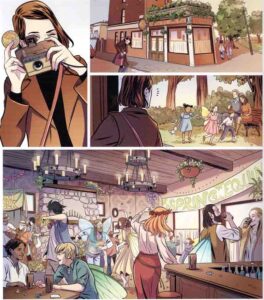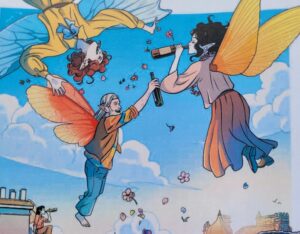Les Humanoïdes Associés offer a new series, Les Fées Des Sixties where the world of the elves meets that of the Beatles. Here is a strange proposal starting with The Disappearances of Imbolc. Follow our opinion on the magic formula of this first volume.
A rock'n'roll powder…

The Fairies of the Sixties opens in the distant past. At the beginning of thetwentieth century, two men meet in the woods to pick mushrooms certainly but much more physical than one might think. By his outfit, one is visibly a member of the elite while the other seems more popular but the meeting takes place far from the city because it is not necessary to be seen by society. The first is married for convenience while the second assumes to be gay. They are close to prolonged contact but one mysteriously disappears.
The story changes in London in the sixties where a young woman, Ailith, arrives from Scotland. She works for a major daily newspaper, the Daily Telegraph. She recently lost her mother. Missing for years, his body has just been found. Ailith came to the capital to expose a fairy plot. There she meets her childhood friend, Elliot, who has become a police officer. This conservative Bobby at best and racist, who especially hates the fairies he blames for the rise in crime. Together, they investigate a series of disappearanceson February 1 , the day of a pagan holiday.
… opens a new universe

Fairies of the Sixties starts from the double meaning of the English word fairy meaning both fairy or in gay slang. This series has a broader purpose than this single volume by proposing a whole new universe: what if the counterculture revolution had taken place at the same time as the revelation of a magical world? Starting from his concept, Gihef developed Fées Des Sixties with Christian Lachenal to mix fantasy, thriller and thriller. Four releases of complete stories in one volume are planned for 2023. Each is done by different creative teams. The disappearances of Imbolc is written by the man who made Blue is a warm color that gave the film La vie d'Adèle. This title is a double first since Jul Maroh is only a writer and it is a fantasy series. Transgender author, he infuses his themes into The Disappearances of Imbolc. Indeed, fairies are for him queer and transgender. Maroh wants to denounce patriarchy when Ailith's colleagues are misogynists.
For the author, magic is not a scripted accessory but his faith. He contacted the fairies and defended paganism abused by several centuries of Christianization. The reader enters Celtic mythology. We discover the powers of the fairies, their ambivalence but also their kingdom. In Primrose Hill Forest, they offer powers in a pact but they lie and are pretentious. This magical world is not perfect. The tribunal of the wise excludes an oracle from Avalon.
Living in London, elves take the subway and shop around. Fairies are a parable of the marginalized excluded by good society. They enjoy life hedonistically and carefree while traditional Londoners praise work. We can think of hippies for the wealthiest or migrants. A girl who is good in all respects questions her values out of love. We can see this refusal of discrimination when poor fairies fall into prostitution or the trafficking of adult powder.
Launching the new universe of the Fairies of the Sixties, The disappearances of Imbolc prove the richness of the mixture. The book begins as a police investigation before becoming a journey into fantasy and a defense of diversity. There are still two other volumes to further enrich this universe.
Find more chronicles on magic with The Witcher and Elves.


















